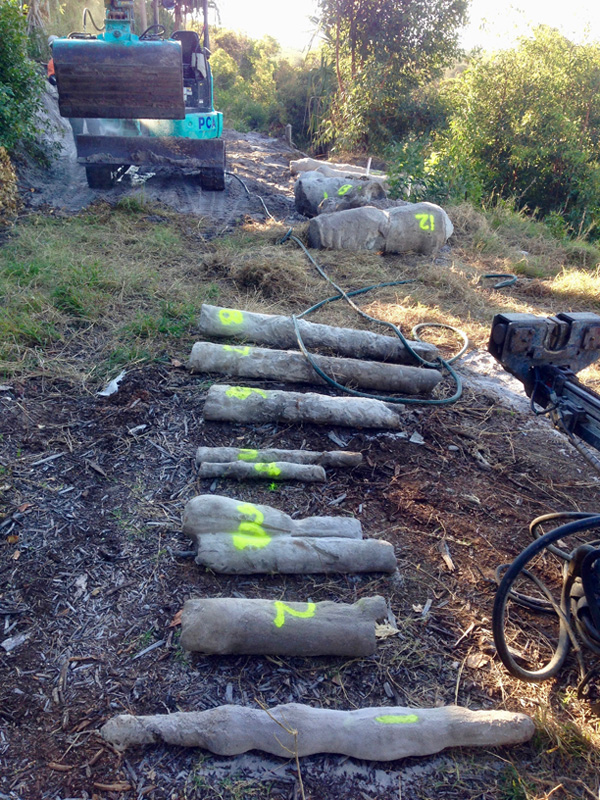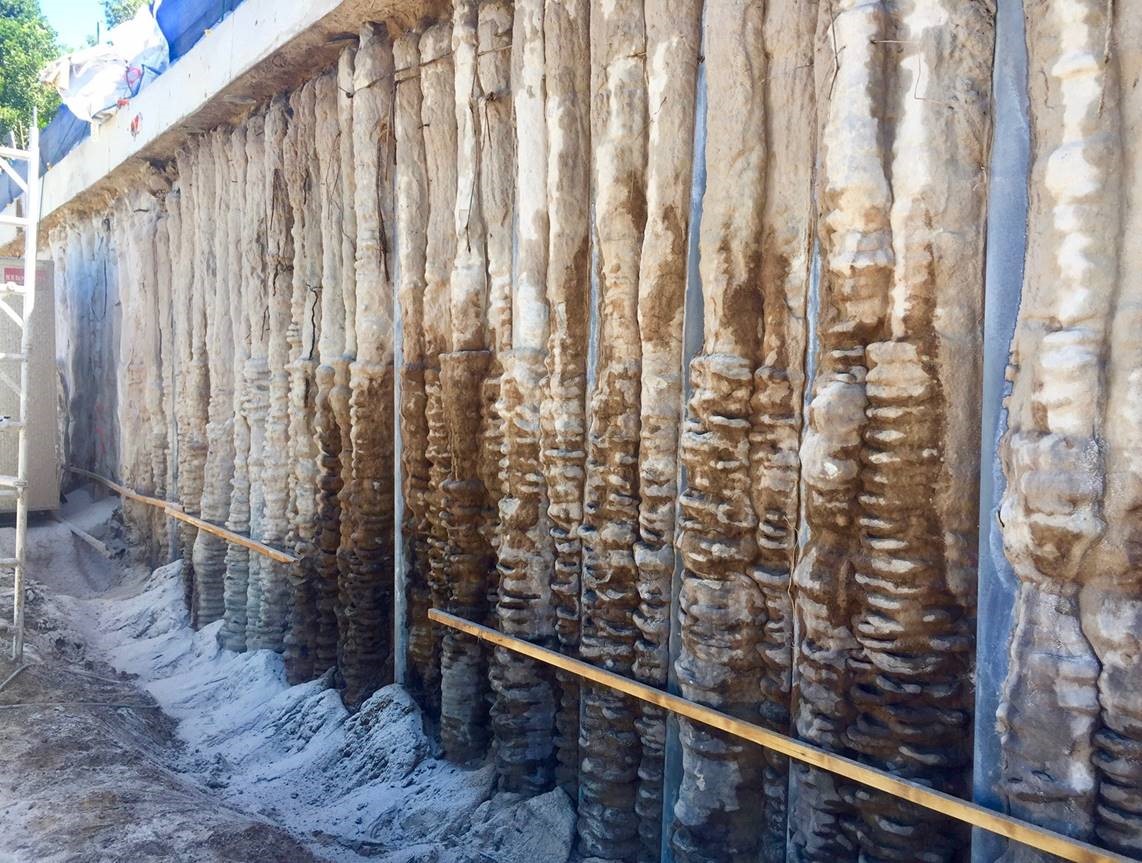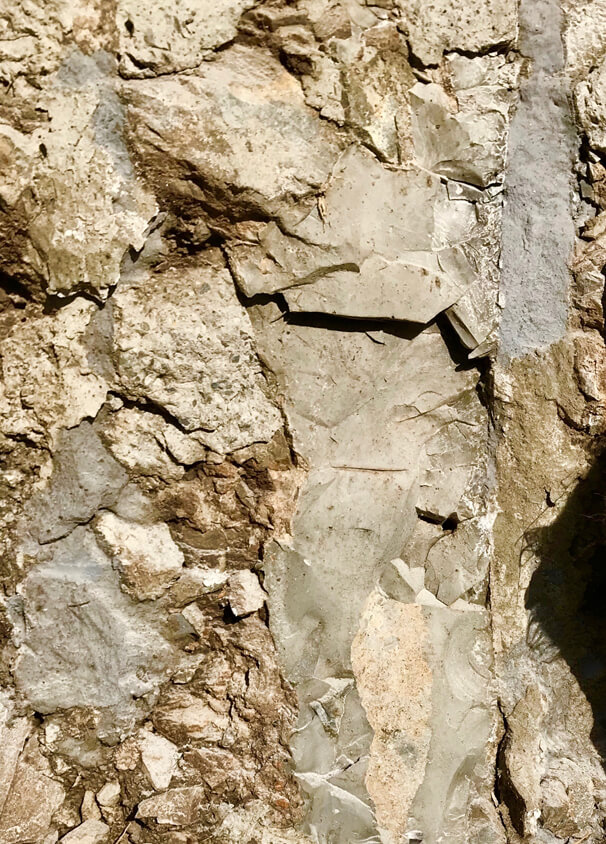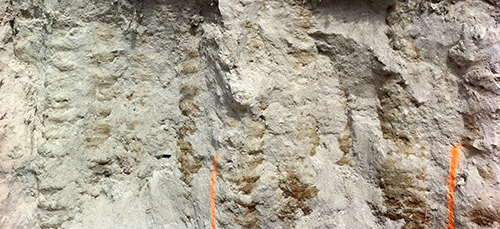Pressure Cement Grouting
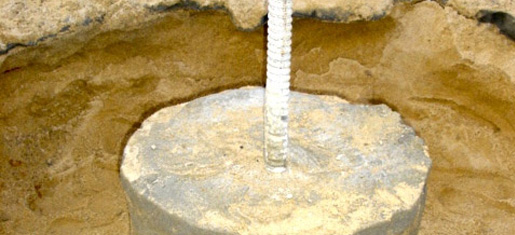 Pressure Cement Grouting is a grouting process that fills pores in granular soil or voids in rock or soil, with grout injected as a flowable medium. Depending on the application, cement grout is injected under pressure at strategic locations via a single or multiple ports. It is essential that the particle size of the grout being introduced is aligned with the site-specific geotechnical conditions; this permits the cement grout to enter the pores or voids effectively. Once treated the grouted mass has an increased strength and stiffness, and reduced permeability.
Pressure Cement Grouting is a grouting process that fills pores in granular soil or voids in rock or soil, with grout injected as a flowable medium. Depending on the application, cement grout is injected under pressure at strategic locations via a single or multiple ports. It is essential that the particle size of the grout being introduced is aligned with the site-specific geotechnical conditions; this permits the cement grout to enter the pores or voids effectively. Once treated the grouted mass has an increased strength and stiffness, and reduced permeability.
Pressure Cement Grouting has been used to reduce water flow through rock formations beneath dams and to cement granular soils to underpin foundations or provide excavation support. Cement grouting to underpin existing structures can provide significant economic advantage over conventional approaches, and can be accomplished where access is difficult and space is limited. Since the effectiveness of cement grouting is independent of structural connections, the technique is readily adaptable to existing foundations. The pressure cement grouting process can be conducted without disruption to an operating facility in most instances.
PCA Ground Engineering has specialised equipment supported by software that allows real-time monitoring of grouting parameters such as volume and pressure during the cement grouting process. PCA’s equipment has the ability to alter and mix grout to accommodate the site specific grouting parameters, such as mix type, flow rate, pressure, and grout volumes based on drilling and grouting data.
Mini Jet and Jet Grouting
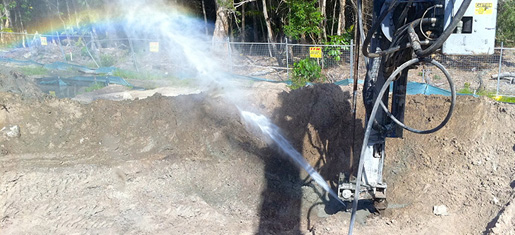 Jet grouting is a grouting technique that soil mixes the in situ stratum to create a soilcrete (grouted soil). A specific grout blend is created to mix with the soil and transform the existing geotechnical characteristics.
Jet grouting is a grouting technique that soil mixes the in situ stratum to create a soilcrete (grouted soil). A specific grout blend is created to mix with the soil and transform the existing geotechnical characteristics.
Grout is introduced into a site via a specialised piling rig, the piling rig simultaneously injects the earth with grout under pressure and blends grout with the existing geology. Soil mixing and improvement can be achieved by high pressure injection of grout, air, water or a combination of all three. The probe or drill head has ports, these ports “jet” the introduced fluid into the soil column eroding and mixing the in situ soil as the drill stem and jet grout are rotated and raised.
The grout injection process involves advancing a drill string to a specific design depth at low pressure, once the drill string reaches the design depth, grout pressures are increased to between 200-700 bar. The variation in pressure combined with a sites specific stratum determines the diameter of the grouted soil column which can be married to the design criteria required.
The soilcrete is created to form columns or panels that are typically designed to achieve a specific strength and permeability. Jet grouting has been used to underpin existing foundations, construct excavation support walls, and construct slabs to seal the bottom of deep excavations.
Jet grouting is effective across a broad range of geotechnical conditions including sands, silts and most clay. It is an erosion-based system so the erosive nature of the soil plays a major role in determining the diameter of the grout columns. Cohesive soils will typically have smaller diameter soilcrete columns than cohesion less soils which are more erodible. It is the geometry and physical properties of the soilcrete that connect this technique to engineering principals for design and construction.
Jet grouting can be conducted in fairly confined spaces and around subsurface obstructions such as utilities, which can provide unique design flexibility. Sites that need to control ground water, stabilize a building platform or excavation in unstable soil conditions are ideal candidates for the utilisation of mini jet or jet grouting.
Jet grouting can often be conducted without disrupting normal facility operations. PCA has highly mobile grouting equipment that enables rapid site establishment, greatly reducing mobilization and demobilization costs. Jet and mini jet grouting can often result in construction program savings over conventional methods.
Microfine Grouting
Microfine grouting is a grouting technique that transforms granular soils into sandstone-like masses, by permeation with a low viscosity grout. The soils best suited for this technique are sands with low fines content. The grout is injected under pressure through the ports located along the length of the pipe. The grout permeates the soil and solidifies it into a mass that has increased strength and stiffness.
Microfine grouting has many applications;
Underpinning, as it can be easily performed where access and space is limited, it does not require a structural connection to the existing foundation being underpinned.
Excavation support, when an excavation is planned immediately adjacent to an existing structure the introduction of microfine grouting can usually be achieved without disrupting normal facility operations.
Tunnelling, microfine grouting can be utilized to stabilise soil around entry and exit break-outs, or to mitigating settlement of overlying structures within the influence of the tunnel alignment.
Fracture Grouting
Fracture grouting, is a grouting technique that intentionally fractures a sites existing stratum, using cement grout. A sleeve port pipe is grouted into a predrilled hole beneath a foundation. The grout is injected under pressure at strategic locations through outlet ports in the pipe. Once the existing stratum capacity to manage the applied pressure is exceeded, fractures open up in the soil which are immediately expanded by the influx of grout, creating intertwined lenses of cured grout. The process results in controlled heave of the overlying soils and structures.
The technique has been used to re level damaged structures or to protect existing structures from potential settlement that might occur due to new construction activities. This technique is also referred to as consolidation grouting when applied proactively i.e. it is utilized to consolidate (reinforce) an area that might otherwise be at risk.
Compaction Grouting
Compaction grouting is a relatively high pressure grouting technique that is used to increase the density of soil. This is achieved by the injection of a fairly viscous grout that pushes the soils to the side. The pressurized grout then typically forms a column, bulb, or series of bulbs as each section of the stratum is treated.
Compaction grouting is well suited for use in loose soils where the grouting process is introduced at specific subsurface locations underneath a structure and is installed in patterns that adhere to the designing engineers specification.
The compaction grouting process makes the in situ soil increasingly dense as water and air are squeezed out from the existing soil particles. This technique can be utilized to arrest or contain a pre existing settlement, or it can be utilized to lift or raise a structure.

